Microstructure and Properties of Aluminum Alloy/Diamond Composite Materials Prepared by Laser Cladding
Abstract
:1. Introduction
2. Materials and Methods
3. Results
3.1. Surface Treatment of Diamond
3.2. Preparation of Aluminum Alloy/Diamond Composite Materials
3.3. Microstructure of Aluminum Alloy/Diamond Composite Materials
3.4. Properties of Aluminum Alloy/Diamond Composite Materials
4. Discussion
5. Conclusions
- Tungsten is deposited on the surface of diamond by magnetron sputtering, and a uniform tungsten carbide layer can be obtained on the diamond surface by short-term vacuum heat treatment at 1150 °C for 15 min.
- Under the conditions of a power of 1500 W, scanning speed of 10 mm/s, spot width of 3 mm, powder feeding speed of 13 g/min, powder feeding gas flow rate of 7 L/min, protective gas flow rate of 15 L/min, and overlap rate of 50%, high-density aluminum alloy/diamond composites and aluminum alloys can be prepared through the laser cladding process.
- With the increase in the diamond content, the density, specific heat, mechanical properties, and average linear thermal expansion coefficient of the material gradually decrease, and the thermal conductivity of the material first increases and then decreases.
- When the diamond content is 15% and the aluminum alloy content is 85%, the thermal conductivity of the composite material reaches 147% of the aluminum alloy matrix, the bending strength decreases to 77% of the aluminum alloy matrix, and the thermal expansion coefficient decreases to 89% of the aluminum alloy matrix.
Author Contributions
Funding
Institutional Review Board Statement
Informed Consent Statement
Data Availability Statement
Conflicts of Interest
References
- McGlen, R.J.; Jachuck, R.; Lin, S. Integrated thermal management techniques for high power electronic devices. Appl. Therm. Eng. 2004, 24, 1143–1156. [Google Scholar] [CrossRef]
- Zweben, C. Advanced composites and other advanced materials for electronic packaging thermal management. In Proceedings of the International Symposium on Advanced Packaging Materials Processes, Properties and Interfaces (IEEE Cat. No.01TH8562), Braselton, Georgia, 11–14 March 2001; pp. 360–365. [Google Scholar] [CrossRef]
- Li, C.; Wang, X.; Wang, L.; Li, J.; Li, H.; Zhang, H. Interfacial characteristic and thermal conductivity of Al/diamond composites produced by gas pressure infiltration in a nitrogen atmosphere. Mater. Des. 2016, 92, 643–648. [Google Scholar] [CrossRef]
- Abyzov, A.M.; Shakhov, F.M.; Averkin, A.I.; Nikolaev, V.I. Mechanical properties of a diamond–copper composite with high thermal conductivity. Mater. Des. 2015, 87, 527–539. [Google Scholar] [CrossRef]
- Zain-Ul-Abdein, M.; Raza, K.; Khalid, F.A.; Mabrouki, T. Numerical investigation of the effect of interfacial thermal resistance upon the thermal conductivity of copper/diamond composites. Mater. Des. 2015, 86, 248–258. [Google Scholar] [CrossRef]
- Tan, Z.; Chen, Z.; Fan, G.; Ji, G.; Zhang, J.; Xu, R.; Shan, A.; Li, Z.; Zhang, D. Effect of particle size on the thermal and mechanical properties of aluminum composites reinforced with SiC and diamond. Mater. Des. 2016, 90, 845–851. [Google Scholar] [CrossRef]
- Abyzov, A.M.; Kidalov, S.V.; Shakhov, F.M. High thermal conductivity composite of diamond particles with tungsten coating in a copper matrix for heat sink application. Appl. Therm. Eng. 2012, 48, 72–80. [Google Scholar] [CrossRef]
- Wang, L.; Li, J.; Bai, G.; Li, N.; Wang, X.; Zhang, H.; Wang, J.; Kim, M.J. Interfacial structure evolution and thermal conductivity of Cu-Zr/diamond composites prepared by gas pressure infiltration. J. Alloys Compd. 2019, 781, 800–809. [Google Scholar] [CrossRef]
- Wang, P.; Xiu, Z.; Jiang, L.; Chen, G.; Lin, X.; Wu, G. Enhanced thermal conductivity and flexural properties in squeeze casted diamond/aluminum composites by processing control. Mater. Des. 2015, 88, 1347–1352. [Google Scholar] [CrossRef]
- Bai, G.; Wang, L.; Zhang, Y.; Wang, X.; Wang, J.; Kim, M.J.; Zhang, H. Tailoring interface structure and enhancing thermal conductivity of Cu/diamond composites by alloying boron to the Cu matrix. Mater. Charact. 2019, 152, 265–275. [Google Scholar] [CrossRef]
- Hanada, K.; Matsuzaki, K.; Sano, T. Thermal properties of diamond particle-dispersed Cu composites. J. Mech. Work. Technol. 2004, 153–154, 514–518. [Google Scholar] [CrossRef]
- Zheng, B.; Zhou, Y.; Smugeresky, J.; Schoenung, J.; Lavernia, E. Thermal behavior and microstructure evolution during laser deposition with laser-engineered net shaping: Part II. Experimental investigation and discussion. Met. Mater. Trans. A 2008, 39, 2237–2245. [Google Scholar] [CrossRef]
- Ostolaza, M.; Arrizubieta, J.I.; Queguineur, A.; Valtonen, K.; Lamikiz, A.; Ituarte, I.F. Influence of process parameters on the particle–matrix interaction of WC-Co metal matrix composites produced by laser-directed energy deposition. Mater. Des. 2022, 223, 111172. [Google Scholar] [CrossRef]
- Ding, L.; Hu, S.; Quan, X.; Shen, J. Effect of Ti on the microstructure evolution and wear behavior of VN alloy/Co-based composite coatings by laser cladding. J. Mater. Process. Technol. 2018, 252, 711–719. [Google Scholar] [CrossRef]
- Gu, D.D.; Meiners, W.; Wissenbach, K.; Poprawe, R. Laser additive manufacturing of metallic components: Materials, processes and mechanisms. Int. Mater. Rev. 2013, 57, 133–164. [Google Scholar] [CrossRef]
- Kováčik, J.; Emmer, S.; Bielek, J. Effect of composition on friction coefficient of Cu–graphite composites. Wear 2008, 265, 417–421. [Google Scholar] [CrossRef]
- Li, N.; Liu, W.; Xiong, H.; Qin, R.; Huang, S.; Zhang, G.; Gao, C. In-situ reaction of Ti-Si-C composite powder and formation mechanism of laser deposited Ti6Al4V/ (TiC+Ti3SiC2) system functionally graded material. Mater. Des. 2019, 183, 108155. [Google Scholar] [CrossRef]
- Faraji, M.; Karimi, S.; Esmailzadeh, M.; Pezzato, L.; Calliari, I.; Eskandari, H. The electrochemical and microstructure effects of TiB2 and SiC addition to AA5052/Al2O3 surface composite coatings in 0.5 M H2SO4 Solution. J. Bio-Tribo-Corrosion 2022, 8, 117. [Google Scholar] [CrossRef]
- Muvvala, G.; Karmakar, D.P.; Nath, A.K. Online assessment of TiC decomposition in laser cladding of metal matrix composite coating. Mater. Des. 2017, 121, 310–320. [Google Scholar] [CrossRef]
- Zhao, L.; Hu, L.; Lin, B.; Wang, Y.; Tang, J.; Qi, L.; Liu, X. Significant improvement of corrosion resistance in laser cladded Zr-based metallic glass matrix composite coatings by laser remelting. Corros. Sci. 2024, 238, 112360. [Google Scholar] [CrossRef]
- Venkatesh, B.; Sriker, K.; Prabhakar, V. Wear characteristics of hardfacing alloys: State-of-the-art. Procedia Mater. Sci. 2015, 10, 527–532. [Google Scholar] [CrossRef]
- Feng, H.; Yu, J.; Tan, W. Microstructure and thermal properties of diamond/aluminum composites with TiC coating on diamond particles. Mater. Chem. Phys. 2010, 124, 851–855. [Google Scholar] [CrossRef]
- Tian, C.; Li, X.; Zhang, S.; Guo, G.; Wang, L.; Rong, Y. Study on design and performance of metal-bonded diamond grinding wheels fabricated by selective laser melting (SLM). Mater. Des. 2018, 156, 52–61. [Google Scholar] [CrossRef]
- Xu, Y.; He, Y.; Huang, G.; Sun, Y.; Li, T.; Xu, X. Numerical simulation and experimental investigation of the molten pool evolution and defects formation mechanism of Selective laser melted CuSn20/Diamond composites. Mater. Des. 2024, 243, 113082. [Google Scholar] [CrossRef]
- Li, Z.-H.; Nie, Y.-F.; Liu, B.; Kuai, Z.-Z.; Zhao, M.; Liu, F. Mechanical properties of AlSi10Mg lattice structures fabricated by selective laser melting. Mater. Des. 2020, 192, 108709. [Google Scholar] [CrossRef]
- GB/T 1423-1996; Test Method for Density of Precious Metals and Their Alloys. The State Bureau of Quality and Technical Supervision: Beijing, China, 1996.
- GB/T 4339-2008; Determination of Thermal Expansion Characteristic Parameters of Metallic Materials. AQSIQ: Beijing, China, 2008.
- GB/T 22588-2008; Flash Method for Measuring Thermal Diffusion Coefficient or Thermal Conductivity. AQSIQ: Beijing, China, 2008.
- ASTM E1269-11; Standard Test Method for Determining Specific Heat Capacity by Differential Scanning Calorimetry. ASTM International: West Conshohocken, PA, USA, 2011.
- GB/T 6569-2006; Test Method for Bending Strength of Fine Ceramics. AQSIQ: Beijing, China, 2006.
- Lei, L.; Bolzoni, L.; Yang, F. High thermal conductivity and strong interface bonding of a hot-forged Cu/Ti-coated-diamond composite. Carbon 2020, 168, 553–563. [Google Scholar] [CrossRef]
- Ciupiński, Ł.; Kruszewski, M.J.; Grzonka, J.; Chmielewski, M.; Zielińsk, R.; Moszczyńska, D.; Michalski, A. Design of interfacial Cr3C2 carbide layer via optimization of sintering parameters used to fabricate copper/diamond composites for thermal management applications. Mater. Des. 2017, 120, 170–185. [Google Scholar] [CrossRef]
- Ma, L.; Zhang, L.; Zhao, P.; Hu, N.; Gong, Z.; Ye, W.; Wei, Q.; Zhou, K.; Yu, Z.; Zhang, Y. A new design of composites for thermal management: Aluminium reinforced with continuous CVD diamond coated W spiral wires. Mater. Des. 2016, 101, 109–116. [Google Scholar] [CrossRef]
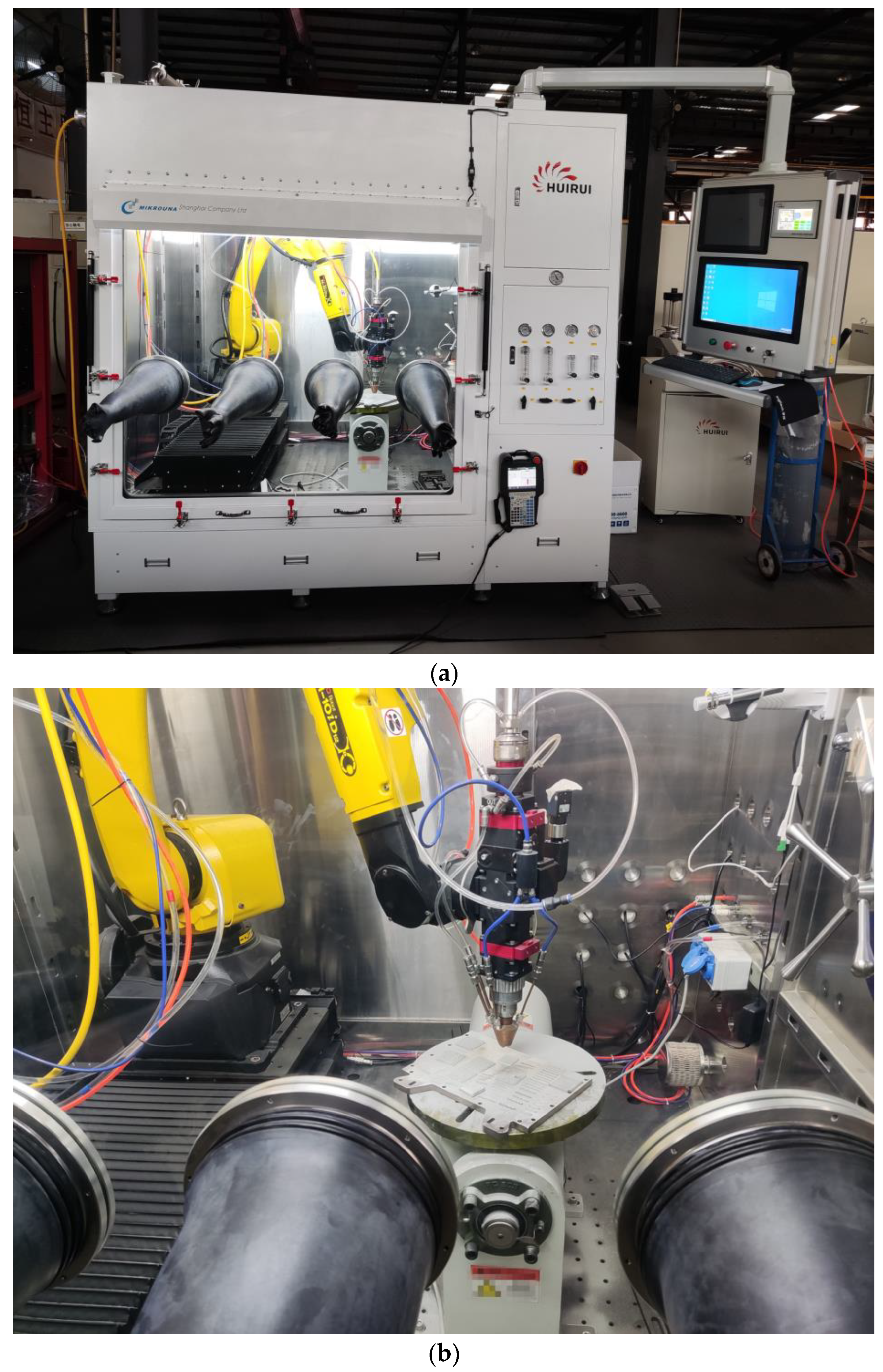

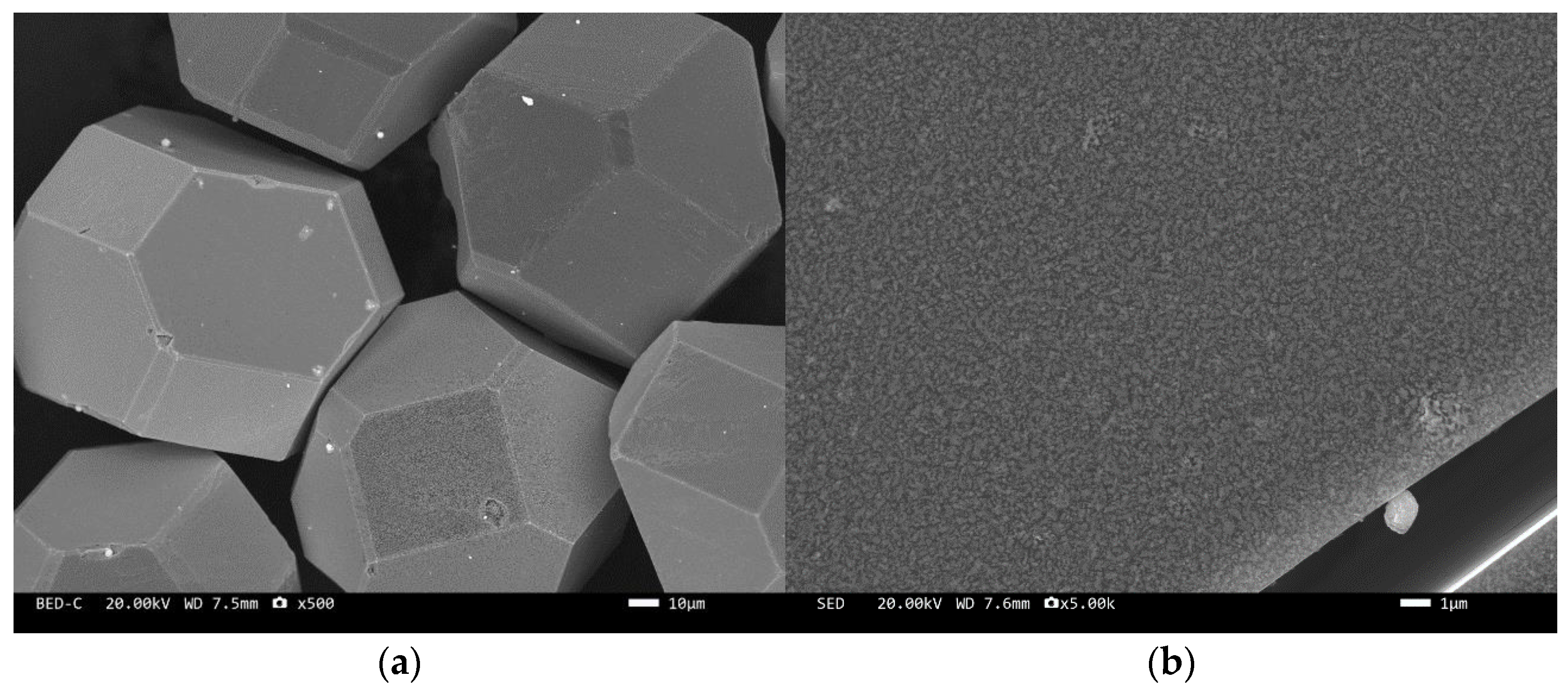
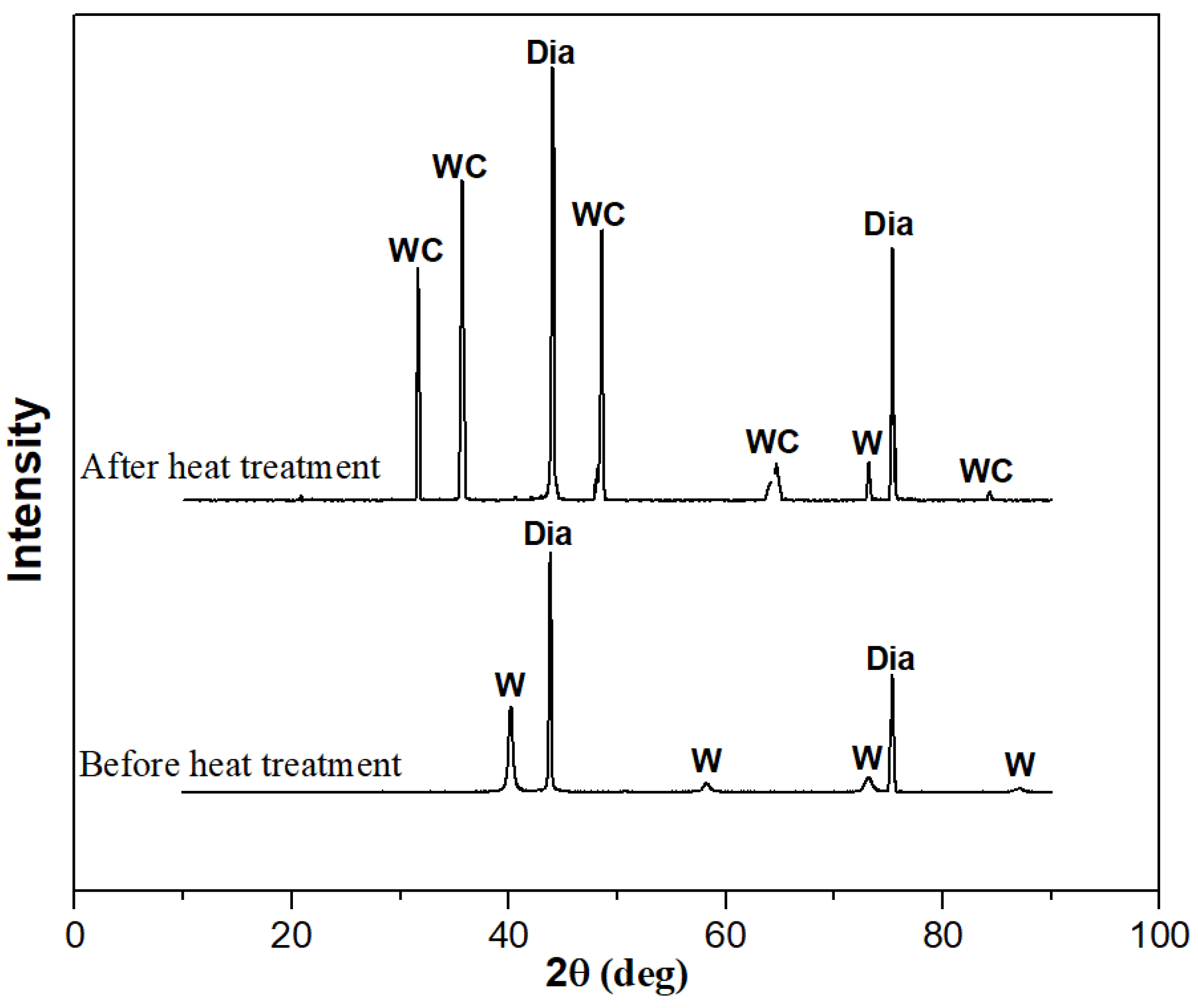
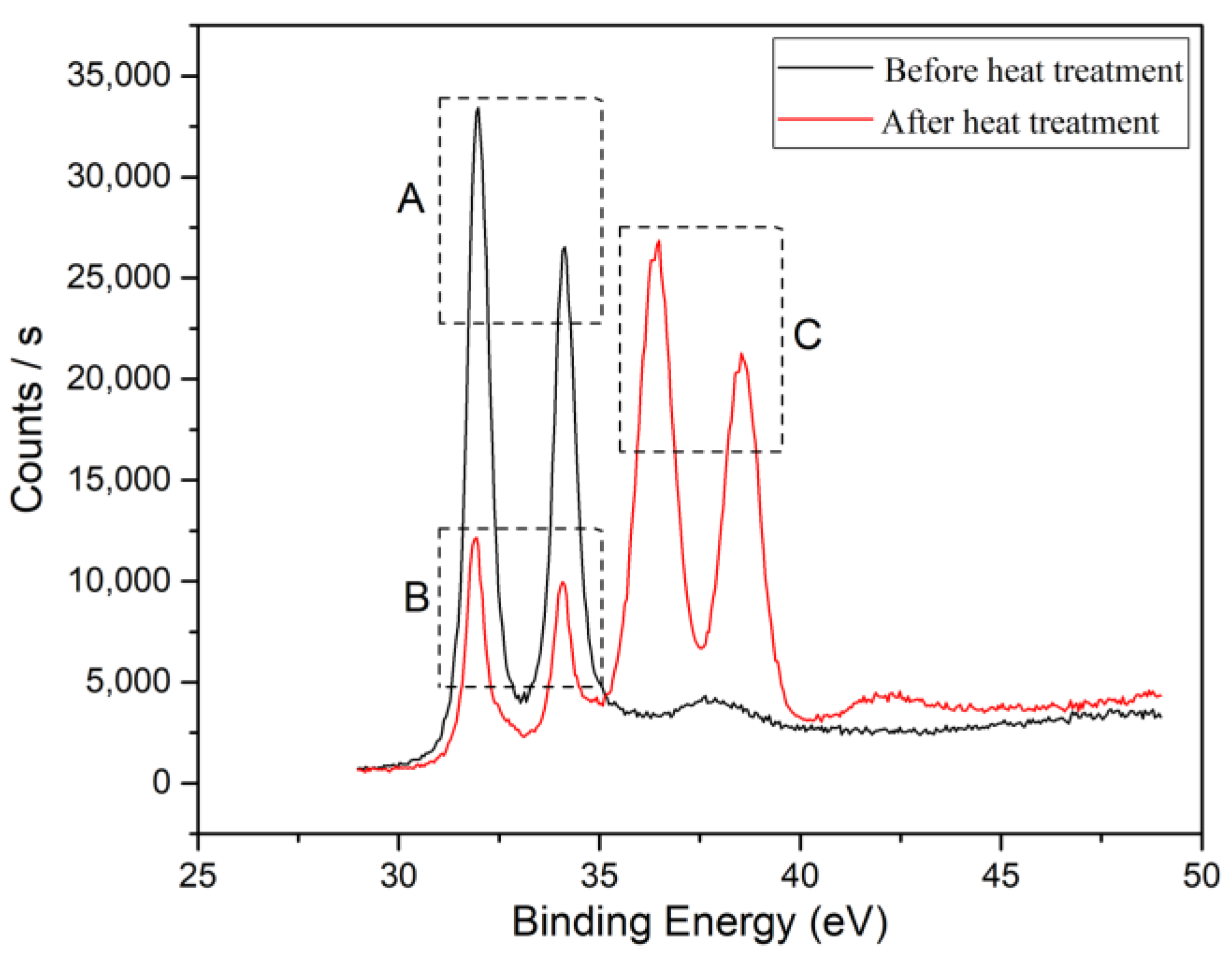
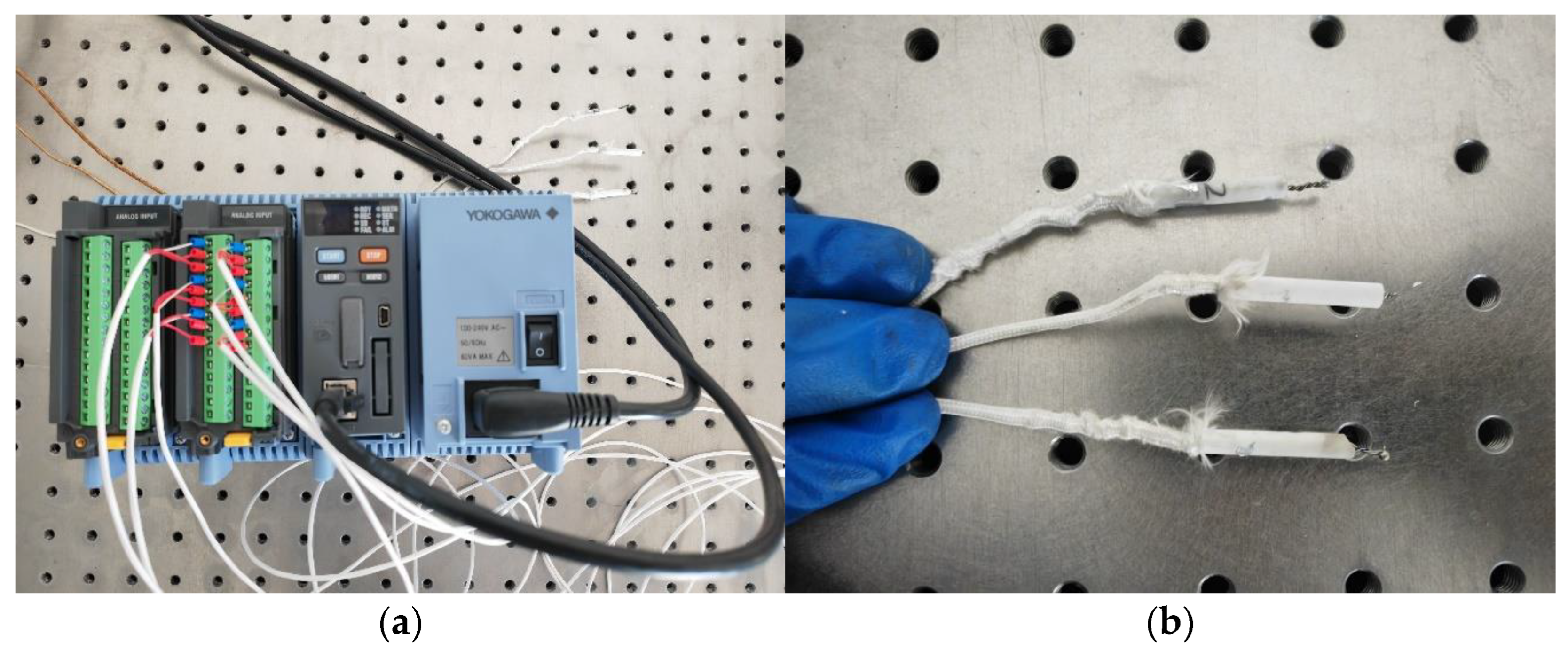
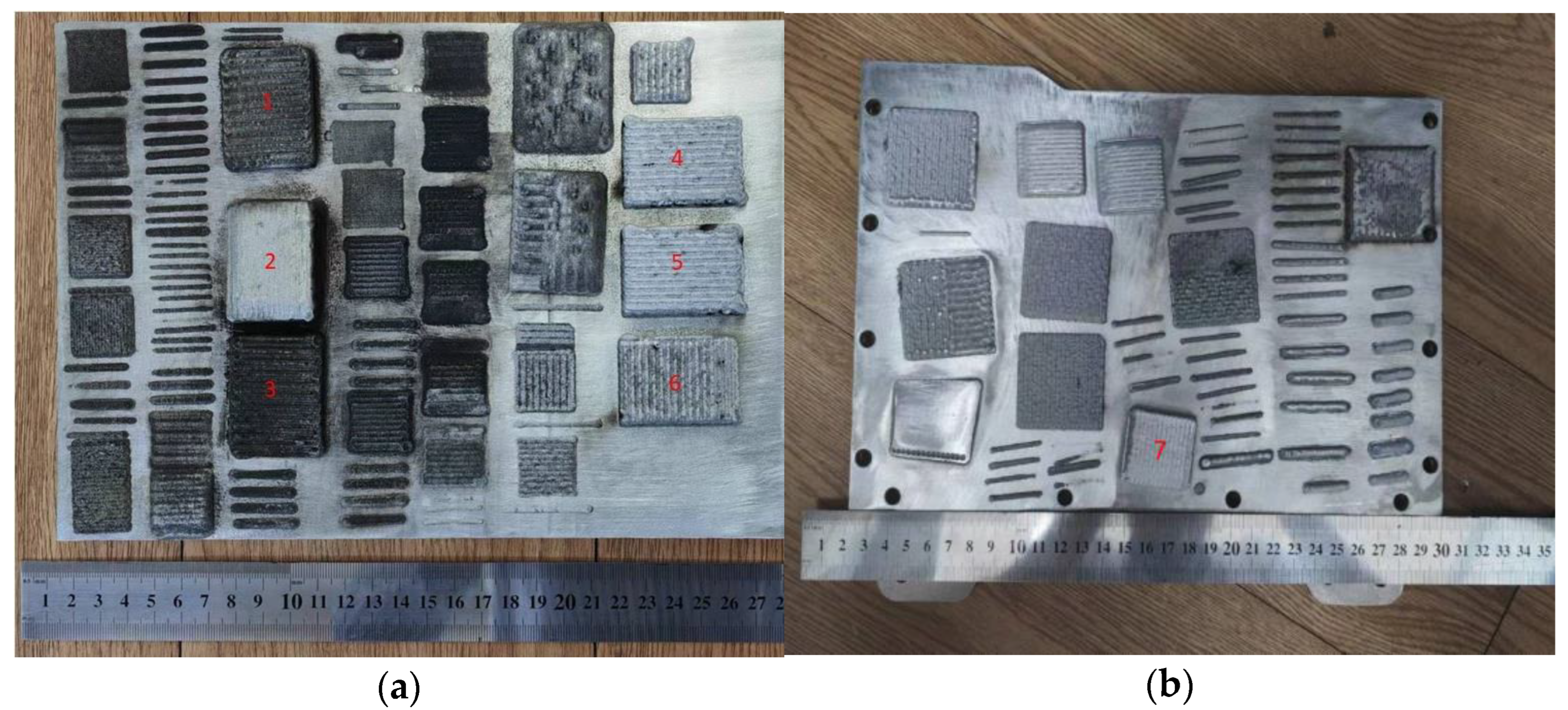

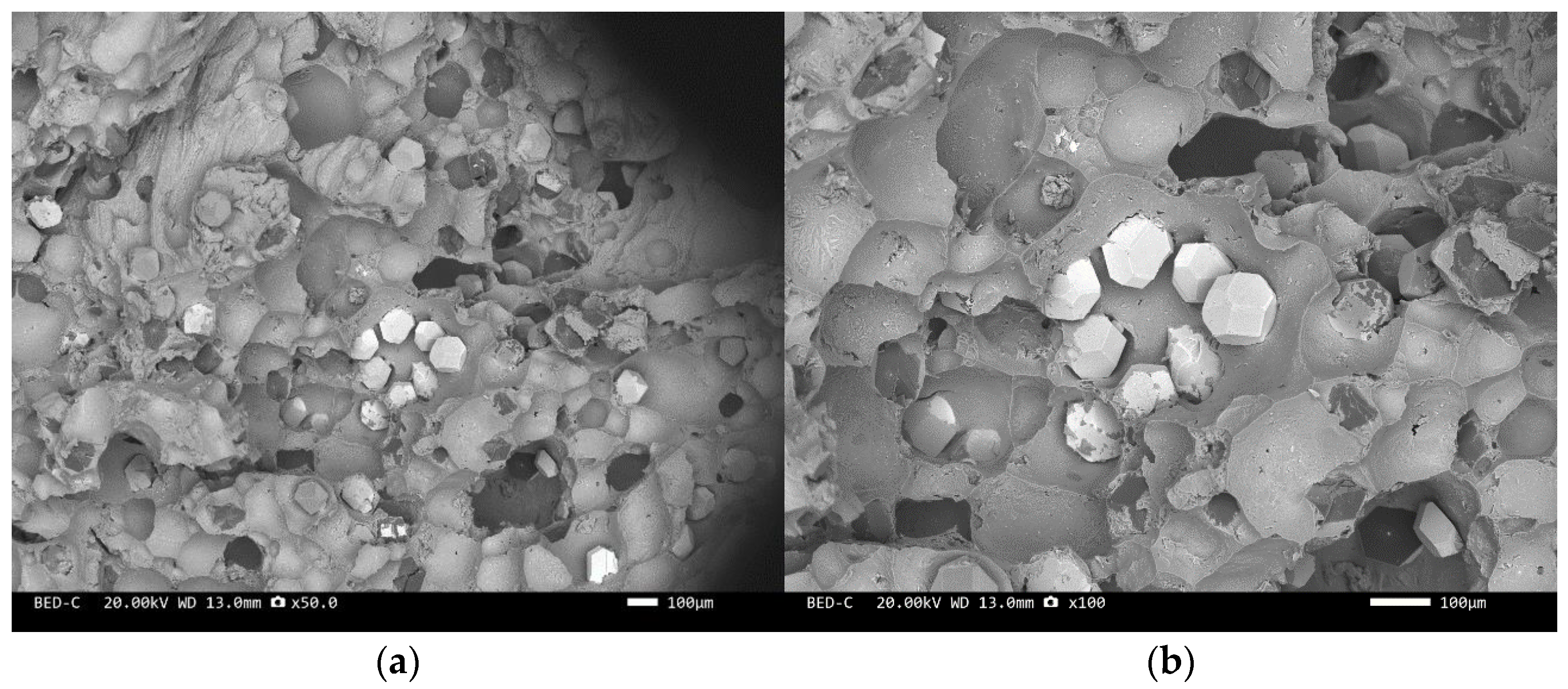
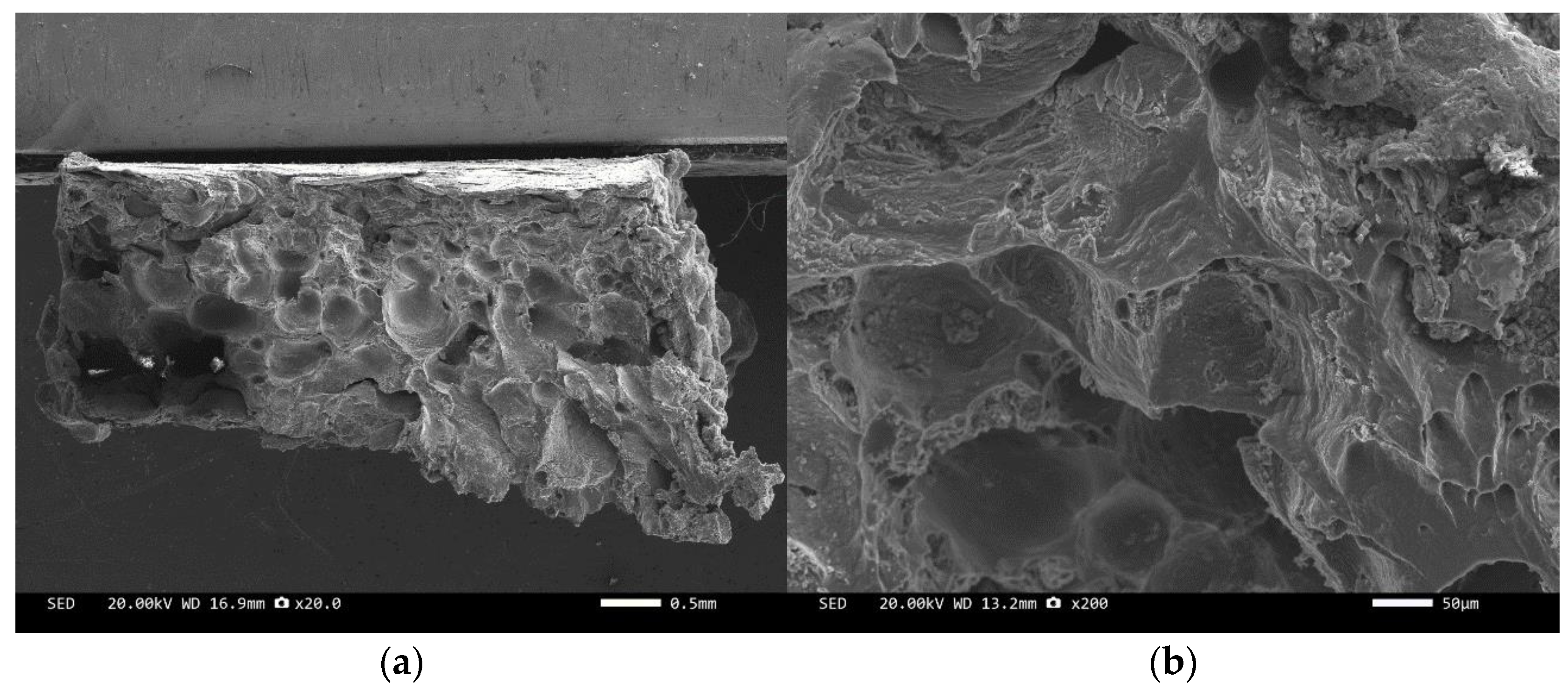
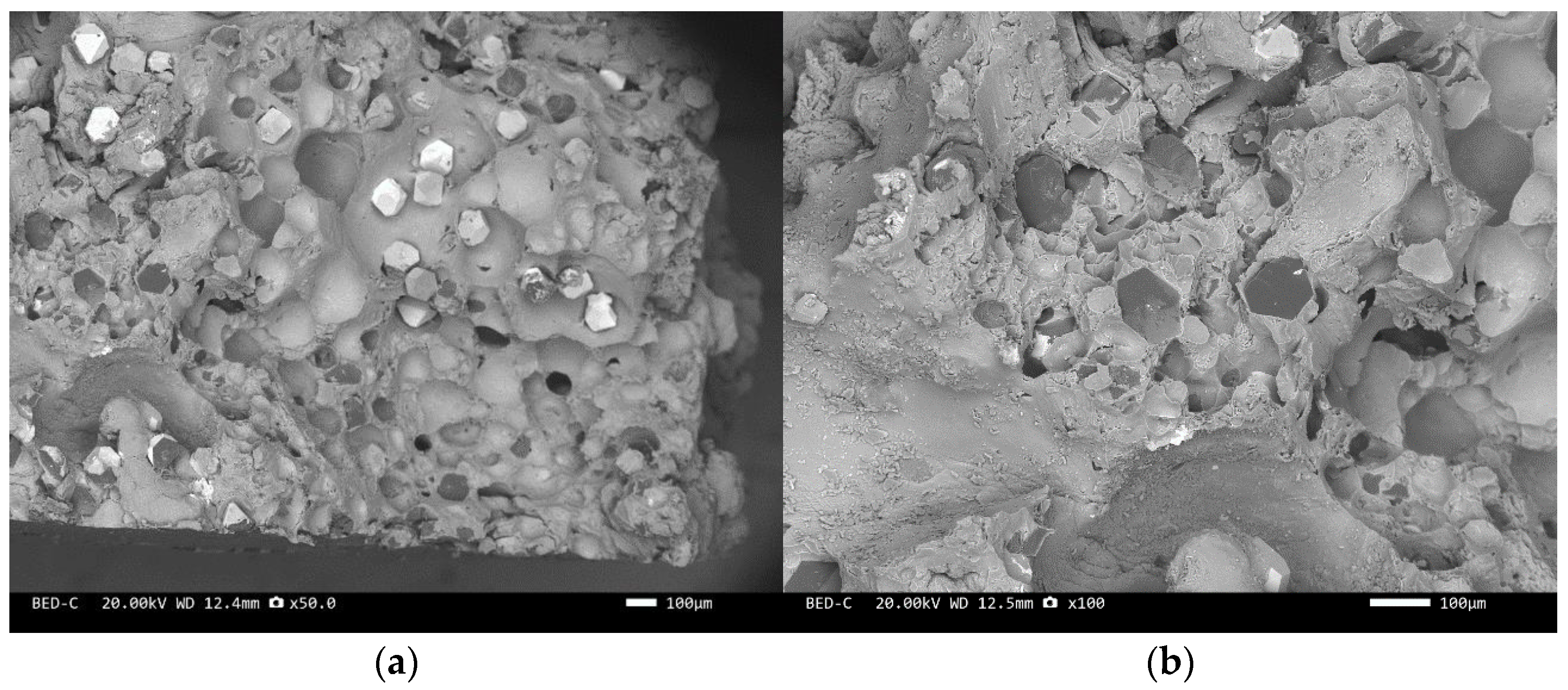
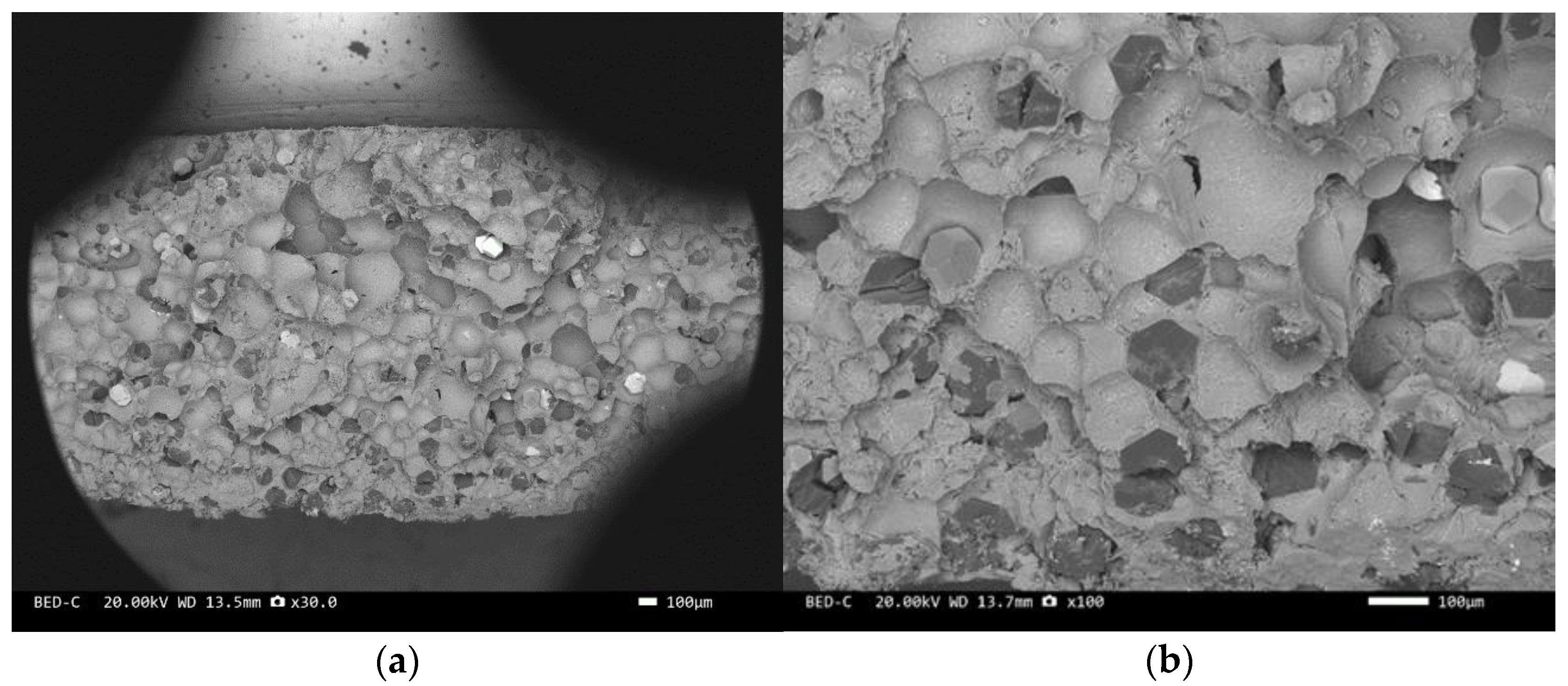
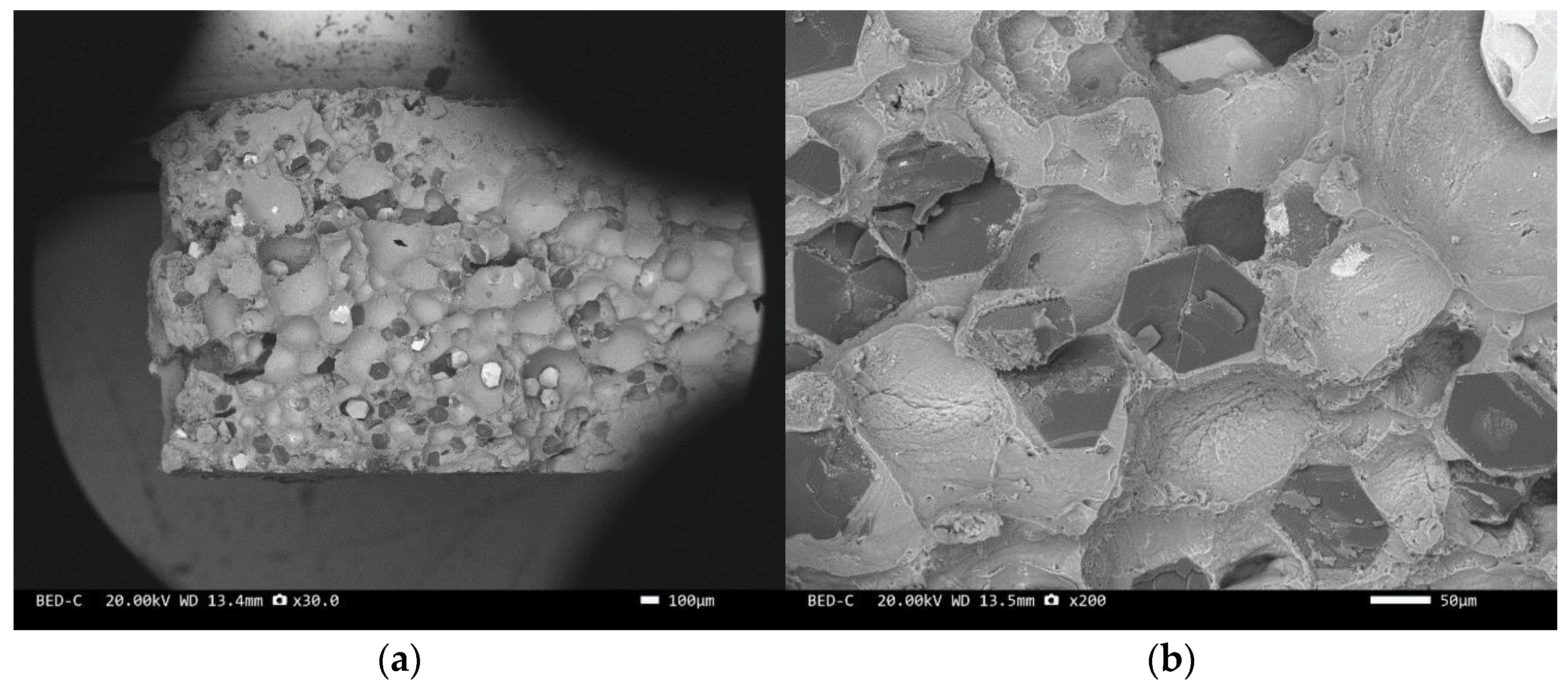

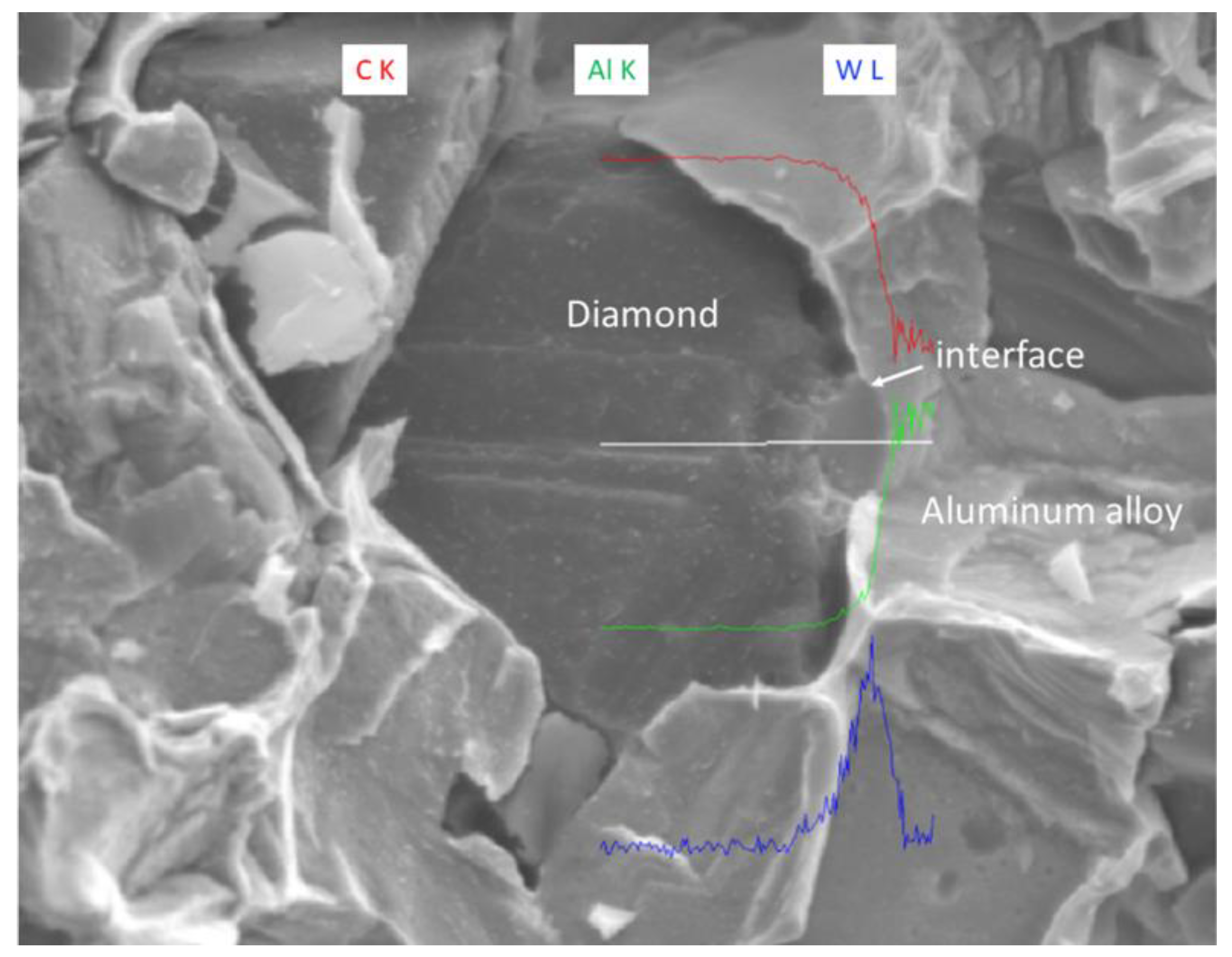
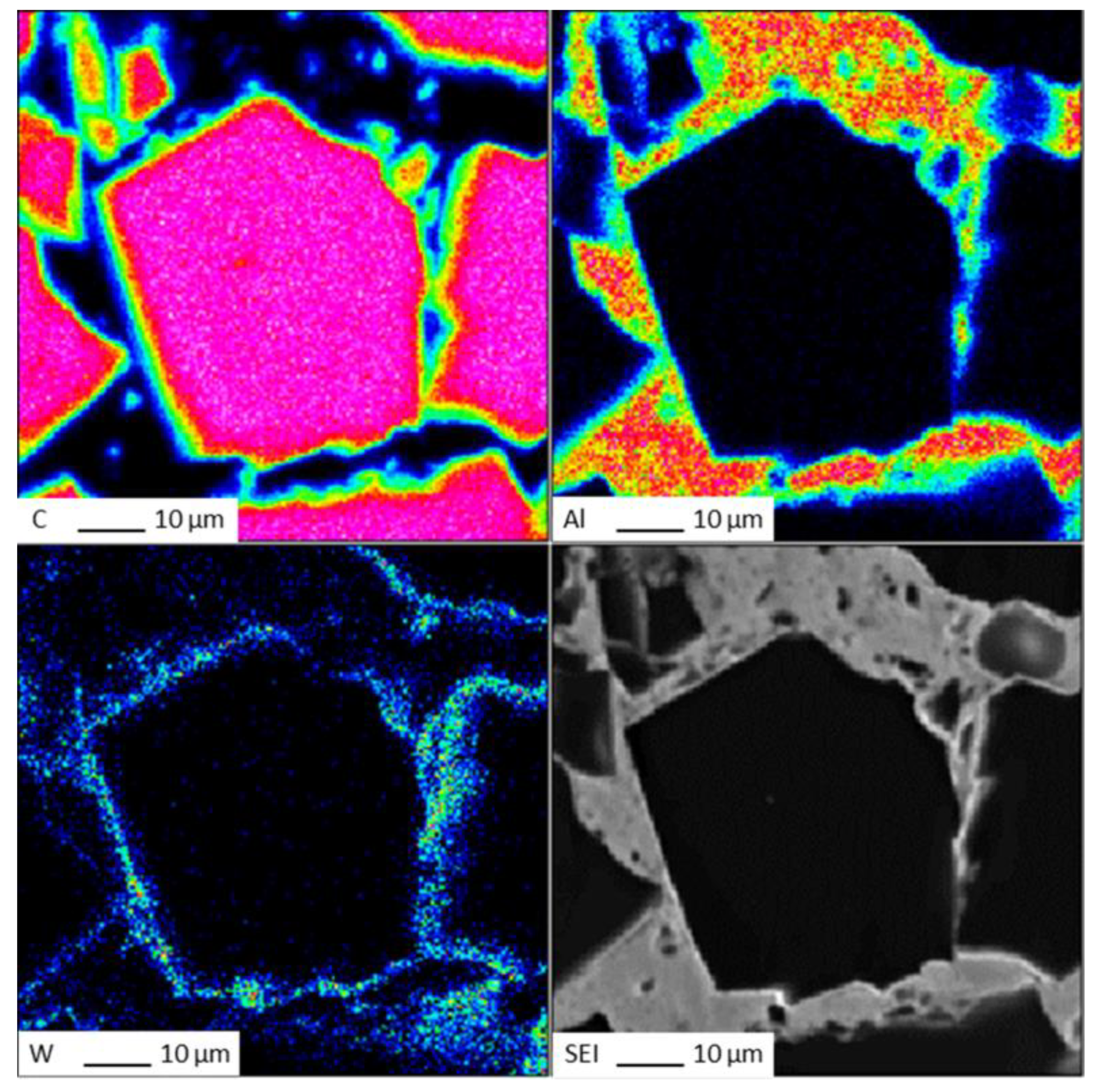

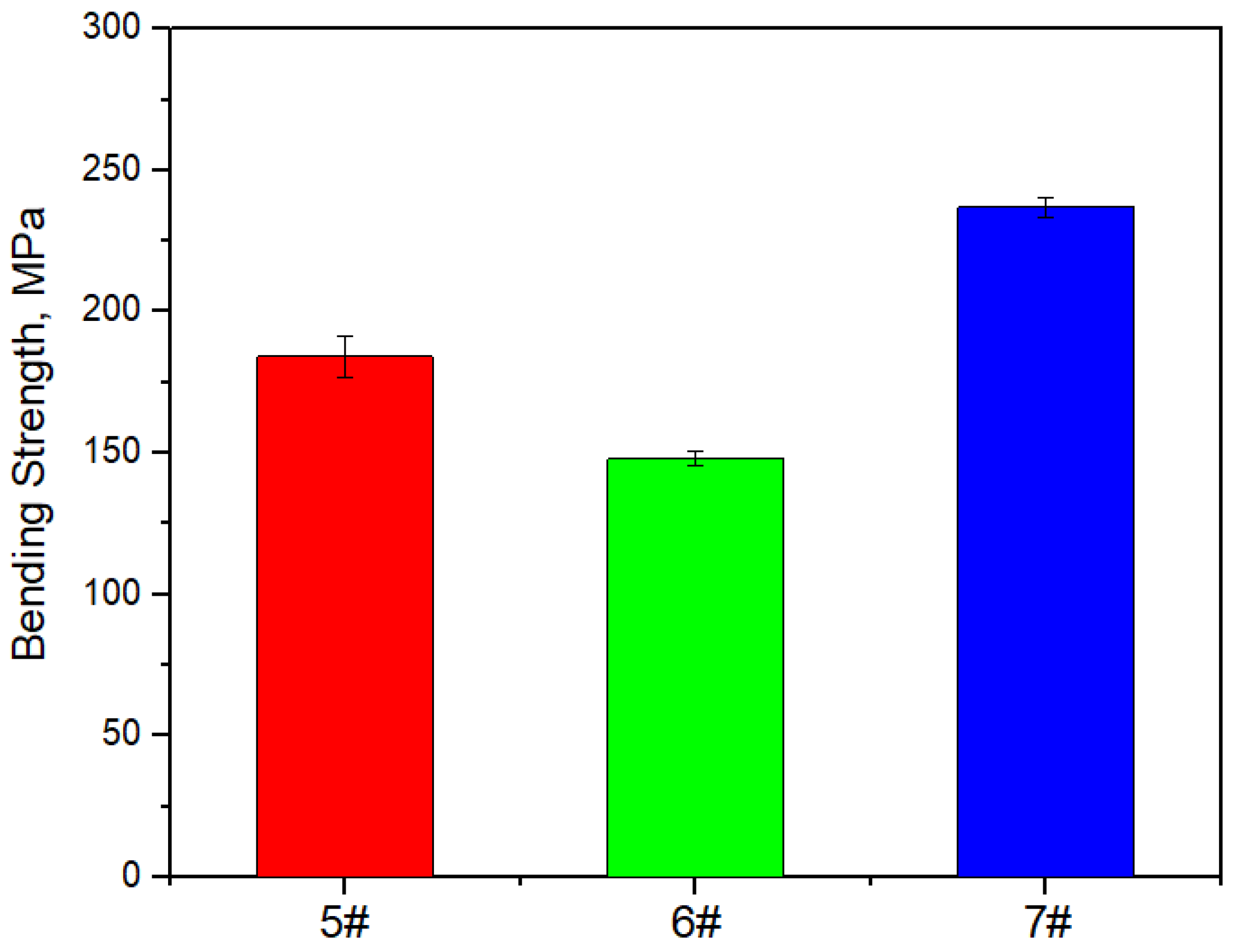
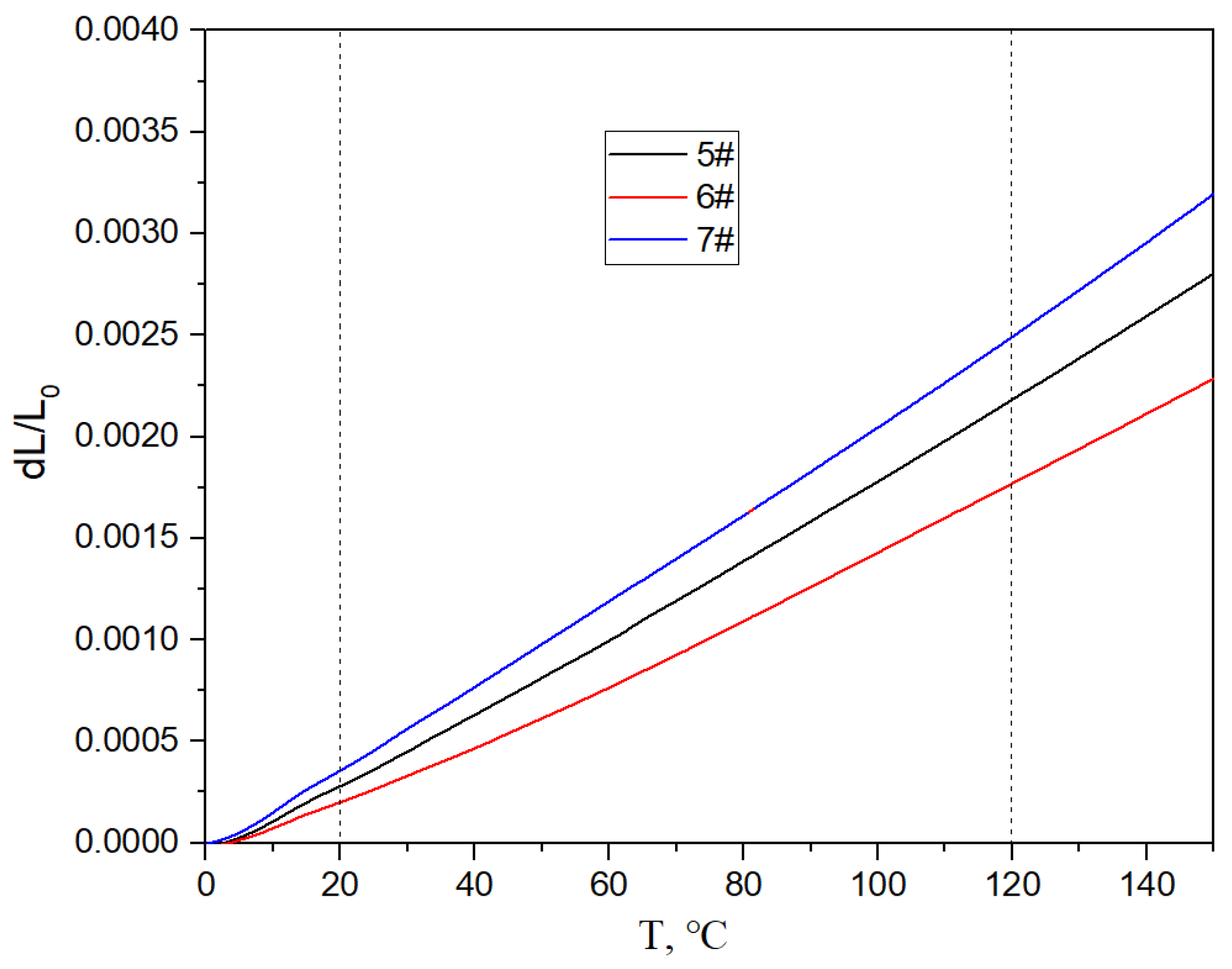
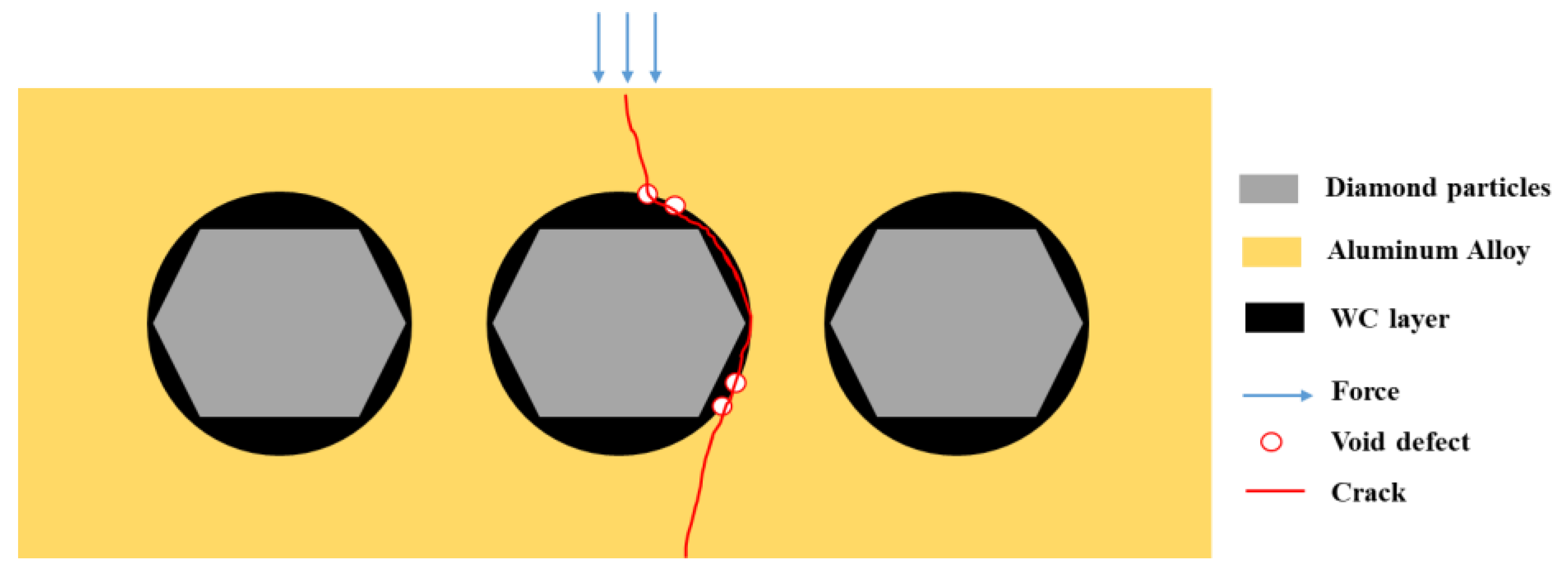

| No. | Time, s | Power, W | Temperature, °C |
|---|---|---|---|
| 1 | 0.2 | 200 | 392 |
| 2 | 0.2 | 500 | 451 |
| 3 | 0.2 | 750 | 496 |
| 4 | 0.2 | 1000 | 907 |
| 5 | 0.2 | 1200 | 940 |
| 6 | 0.2 | 1400 | 1302 |
| 7 | 0.2 | 1600 | Burn down |
| Name | Component | Power, W |
|---|---|---|
| 1# | 70% Aluminum alloy + 30% Dia | 1600 |
| 2# | 70% Aluminum alloy + 30% Dia | 1400 |
| 3# | 85% Aluminum alloy + 15% Dia | 1600 |
| 4# | 85% Aluminum alloy + 15% Dia | 1400 |
| 5# | 85% Aluminum alloy + 15% Dia | 1500 |
| 6# | 70% Aluminum alloy + 30% Dia | 1500 |
| 7# | 100% Aluminum alloy | 1500 |
| Name | Weighted Density, g/cm3 | Drainage Method | Porosity, % | ||
|---|---|---|---|---|---|
| Mass in Air, g | Mass in Water, g | Measured Density, g/cm3 | |||
| 5# | 2.86 | 0.5842 | 0.3710 | 2.74 | 4.20% |
| 6# | 2.94 | 0.5705 | 0.3502 | 2.59 | 11.90% |
| 7# | 2.70 | 1.2916 | 0.8060 | 2.66 | 1.48% |
| Name | ρ, g/cm3 | c, J/gk | α, mm2/s | λ, W/mK | Bending Strength, MPa | Linear Coefficient of Thermal Expansion, 1/K |
|---|---|---|---|---|---|---|
| 5# | 2.74 | 0.780 | 93.90 | 200.68 | 184 | 1.904 × 10−5 |
| 6# | 2.44 | 0.744 | 83.73 | 161.34 | 148 | 1.575 × 10−5 |
| 7# | 2.66 | 0.886 | 57.60 | 135.75 | 237 | 2.140 × 10−5 |
Disclaimer/Publisher’s Note: The statements, opinions and data contained in all publications are solely those of the individual author(s) and contributor(s) and not of MDPI and/or the editor(s). MDPI and/or the editor(s) disclaim responsibility for any injury to people or property resulting from any ideas, methods, instructions or products referred to in the content. |
© 2024 by the authors. Licensee MDPI, Basel, Switzerland. This article is an open access article distributed under the terms and conditions of the Creative Commons Attribution (CC BY) license (https://creativecommons.org/licenses/by/4.0/).
Share and Cite
Huang, S.; Zhao, Y.; Xie, H.; Guo, H.; Peng, L.; Zhang, W. Microstructure and Properties of Aluminum Alloy/Diamond Composite Materials Prepared by Laser Cladding. Materials 2024, 17, 5280. https://doi.org/10.3390/ma17215280
Huang S, Zhao Y, Xie H, Guo H, Peng L, Zhang W. Microstructure and Properties of Aluminum Alloy/Diamond Composite Materials Prepared by Laser Cladding. Materials. 2024; 17(21):5280. https://doi.org/10.3390/ma17215280
Chicago/Turabian StyleHuang, Shuhui, Yilin Zhao, Haofeng Xie, Hong Guo, Lijun Peng, and Wenjing Zhang. 2024. "Microstructure and Properties of Aluminum Alloy/Diamond Composite Materials Prepared by Laser Cladding" Materials 17, no. 21: 5280. https://doi.org/10.3390/ma17215280
APA StyleHuang, S., Zhao, Y., Xie, H., Guo, H., Peng, L., & Zhang, W. (2024). Microstructure and Properties of Aluminum Alloy/Diamond Composite Materials Prepared by Laser Cladding. Materials, 17(21), 5280. https://doi.org/10.3390/ma17215280





